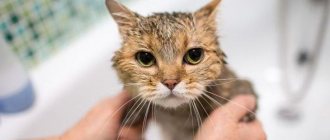Any cat owner will confirm that one of the most difficult aspects of caring for a pet is bathing it. Most cats cannot stand water, so washing your cat without scaring him or leaving him bitten and scratched is an almost impossible task. Why is this happening? Can an owner teach a cat not to be afraid of water, or bathe an animal without harm to both parties - something out of the realm of science fiction?
Is it necessary to do this at all?
Some owners argue as follows: since cats themselves are very clean, it is not at all necessary to subject them to the enormous stress that is bathing at home. This opinion is wrong. How to properly bathe a cat can only be learned by approaching this issue with all responsibility. It must be said that it is necessary to wash cats for the reason that dust and dirt gradually accumulate on their fur, which cannot be cleaned out with a rough tongue. Cats are real clean people, and therefore they will lick themselves endlessly, trying at all costs to get rid of any dirt. This excessive littering can lead to a large accumulation of cat hair in the stomach and cause a number of diseases.
You should wash your cat no more than once or twice every six months. Of course, a lot will depend on what kind of coat she has. If a cat wears a luxurious fur coat, then he will have to be bathed more often. Grooming is especially necessary for show animals before important events. In other cases, you need to wash your purr as needed.
Maintenance and hygiene of cats
The cat is characterized as a clean and tidy animal that regularly performs hygienic care for its fluffy fur.
But, due to physiological characteristics, not all parts of the body are accessible to the pet, so her beloved owner comes to her aid. It so happens that cats, by natural instinct, are very afraid of water. And if some representatives of the genus tolerate bathing procedures more loyally, others create a real problem for their owners. At the sight of a basin of water, the cat begins a real battle: it tries with all its might to escape from the person’s hands, scratches, bites and has absolutely no control over its actions.
To calm down the furious ardor of a frightened animal, one has to use physical force, which is not very correct in relation to it. Is it possible to wash a cat in a calm environment, without violent actions towards it and injuries in the form of bites and scratches on the owner?
Preparing for a swim
If the owner is not very experienced in this matter and the cat is not particularly calm about the proximity of water, the help of an assistant will probably be useful. This person must be at least neutral towards this type of animal, and the cat knows and loves him.
All the necessary components of the process must be prepared in advance and arranged so that you do not need to reach for them again. It is advisable to lift all breakable, cutting and piercing objects to the upper shelves or even remove them from the bathroom. Cats don't like slippery surfaces, so it's best to place a rubber mat at the bottom of the bathtub.
Immediately before bathing, it is advisable to additionally clean the animal’s coat. This is especially important for long-haired breeds, since matted wool during the washing process will become so entangled in the total mass of the coat that it will be almost impossible to remove it. It's a good idea to trim or file your cat's nails to prevent injury.
After the bath and props are ready, the cat is diligently brushed and purrs from the excess of affectionate words and strokes spoken by the owner, you need to place cotton swabs in her external auditory canals to prevent water from entering them.
Is it possible to wash a cat in winter?
All girls are lovers of baths and hygiene. Accordingly, you want to keep an eye on and care for your furry friends. But no! You should not wash your cat in winter.
If such a need arises, be it in heat, or another overturned bowl, you can bathe the girl, but without fanaticism.
And be sure to style it thoroughly after the procedure. You can read about good combs for long-haired cats here . It is recommended to buy furminators and other special devices.
When to accustom a cat to water procedures?
How to bathe a cat? It is extremely important to “introduce” a cat to the bathroom at a young age. There is an opinion that if the kitten is not accustomed to regular washing in time, then later you will not be able to do this. Representatives of the cat breed are very sensitive to their habits, so you need to make sure that they are formed in advance. The little kitten will look to you for protection, and most likely will perceive washing as something inevitable. An adult animal will definitely release its claws in the event of such an unforeseen circumstance and may inadvertently inflict deep scratches on the owner.
Bathing a mustachioed pet: is it necessary?
It is possible and necessary to bathe a cat, but it should not be done as often as the owners sometimes think. It is recommended to subject a mustachioed family member to water procedures only when necessary. The same applies to hairless cats.
Soap for cats:
- tar (from 25 to 100 rubles/piece).
Dry shampoo:
- Pet`s Lab (from 130 to 155 rubles);
- 8 in1 Perfect Coat Waterless Shampoo (about 380 RUR);
- Trixie (from 50 to 90 rubles depending on volume);
- Merial Frontline Pet Care (from RUB 500).
Regular shampoo:
- Trixie (≈ 70 rub.);
- AnimAll Katzen Shampoo (from 60 to 85 rubles);
- VetExpert Hypoallergenic Shampoo (≈ 150 rub.);
- 8 in1 Tearless Kitten Shampoo (≈ 170 rub.);
- “Elite professional” (from 230 rub.);
- “Biovax” (≈ 130 rubles);
- various antiparasitic.
For cats with allergies, you can use egg yolk for washing, washing it off with a decoction of string and/or chamomile.
How to behave while swimming?
Try to calm your pet before washing. Say kind words to him (cats are very good at picking up and perceiving a person’s intonation and feeling his mood), pet him, repeat that this is a necessary procedure because he has gotten dirty. It would be a misconception to believe that cats are not capable of deep feelings for their owner. Almost always, these cute fluffies are so attuned to a person that they are able to have a beneficial effect on him.
During the process itself, hold the animal firmly, but not too tightly, with one hand, and carry out the washing procedure directly with the other. How to bathe a cat without consequences? First of all, you must be confident in yourself. Calm your pet if the situation requires it, and, if possible, try to perform all the necessary manipulations as soon as possible. Not a single cat will tolerate such “mockery” for long. It’s better to keep it to 5-10 minutes; you don’t need to count on more.
How to properly bathe a shy cat when he scratches?
Many people note that it can be even easier to bathe a small kitten than an adult animal. Kittens are not so timid; they quickly come to terms with bathing as if it were inevitable, even if they don’t like the process. In addition, it is easier to handle babies by holding them in the desired position.
A domestic cat, for example, can suddenly show powerful resistance: it will scream, struggle and scratch, splashing a lot of water around.
But there are some useful tips that will help you cope with bathing:
- Get your pet used to bathing. Let the whole process turn into a kind of training. For example, you can treat your cat with his favorite treat after a bath.
- Be kind , speak gently, and never yell at the animal.
- Keep in mind that bathing can be stressful for your cat. Try to distract him with toys and conversation.
- Be persistent , but don't frighten your pet even more.
- The optimal solution is to bathe the cat together if it resists strongly. One person will be able to secure the animal well (you can only hold it by the paws and withers, you cannot squeeze it across the body), and the second will do the washing.
The main thing is to take into account all the nuances, do not offend or frighten the cat, do not provoke aggression from him.
Bath accessories
Before washing, do not forget to prepare everything you need so that your cat does not get scared. Remember: it will not stay in the water for long, so it is extremely important that you have everything at hand. How to bathe a cat and what should be prepared? Shampoo (it should already be on the table next to the bathroom), a soft brush for combing the coat, a special towel for drying, perhaps a small basin or bath.
Many cat owners prefer to wash their pets in small containers, believing that this way they will experience less stress. In fact, a lot depends on your mood. There is no need to buy a baby bathtub. How to bathe a cat if he stubbornly refuses to stand in the container prepared for him? Act gently, be patient and affectionate.
Features of washing cats of different breeds
Some breeds have their own characteristics for water procedures. Individuals with short hair bathe less often than their long-haired counterparts. The Sphynx breed has many different rumors about washing; they supposedly need to be bathed every week.
In fact, it is much better to wipe them regularly with a damp cloth or cloth. You should only bathe if you are heavily soiled. The Burmese cat has a very beautiful shiny coat, the appearance of which must be maintained in this condition. If you do not carry out care procedures, the cover may become similar to hedgehog spines. Such pets need to be regularly wiped with chamois and wet wipes. Such manipulations will give the hair a characteristic beautiful shine.
Brushing is done once a week. To do this, you can use a special glove, brush, and antistatic agent.
Coons and Britons have particularly sensitive skin. For them, you should carefully select veterinary shampoos that are suitable for the animal’s coat type. If you use low-quality cosmetics, the animal’s skin may begin to itch, dandruff or other negative consequences may appear.
Special shampoos
How to wash a cat without damaging its eyes? When it’s the face’s turn, you will need “No Tears” kitten shampoo. As a last resort, if it is not at hand, use a children's analogue.
It's time to apply the color intensifying shampoo. Today, such products are available for sale for all colors. It is recommended to use only those that will enhance the natural color of the coat, and not artificially color it. Then the shampoo should be rinsed off thoroughly. Finally, apply conditioner, leave it on the coat for 2-3 minutes and rinse thoroughly. The procedure is completed. Now you know how to wash a cat. It remains to be seen what to do with him next.
Water temperature
When preparing a bath for your pet, there are several factors to consider. Firstly, the water should not be too hot, otherwise you risk causing your pet burns of varying degrees of intensity. You should not dip your cat in cold water - he may catch a cold and get sick.
How to bathe a cat without any special consequences for it? Place your pet in the water carefully, trying not to scare it. Make sure that water does not get into the ears. It is not necessary to wash the hair, just wet the rest of the hair and gently rinse it with a special shampoo.
How to wash a cat if she is afraid of water
Many owners get injured while bathing their pet because they do it incorrectly.
Some experts believe that cats are not afraid of water, but are afraid of drowning. Therefore, they get very nervous, break out and meow.
Experts advise performing the following manipulations:
- first, find yourself a partner: one person should hold the pet, and the second should soap it;
- refuse to fill the bathtub, it is better to use a basin and a bathtub, you need to prepare a towel in advance;
- Do not turn on the shower under any circumstances: the noise of the water can frighten the animal;
- using a ladle or other container, wet the cat's fur and lather it, but this must be done slowly, with measured movements;
- For bathing, you can use only shampoos specially produced for animals, and cats do not need balms and conditioners at all;
- water should not get into the eyes, nose, mouth and ears (the latter can be plugged with cotton wool for safety);
- monitor the water temperature - 30-38 degrees;
- during the procedure, try to calm the animal, talk to it;
- wash off the foam using a ladle;
- do not make sudden movements yourself and under no circumstances raise your voice at your pet;
- After bathing procedures, wrap your pet in a towel.
After bathing, the animal must be calmed down. For example, stroke your pet's fur or hold it in your arms.
Food is a tranquilizer of unpleasant emotions, so be sure to give your pet something tasty.
By the way, cat breeds such as May Coons and Chauses are not at all afraid of water.
However, many have noticed that quite often cats look fascinated at the water in a full bath or like to lie in it.
As animal psychologists explain, cats are curious animals; they carefully study an unfamiliar space.
Sometimes the animal itself jumps into the bathtub with water, at this moment it is just possible to wash the pet.
The sooner you introduce your pet to the bath, the faster he will get used to it.
Very important! Veterinarians do not allow pets to be bathed before three months.
The pet may not tolerate much stress or become seriously ill.
In addition, make sure that there is little water, and the pet can stand on the surface without slipping, in this case there will be less fear in the eyes.
Pour just a little water and try to throw the cat into the “pond”, then start talking to him, playing, and performing distracting actions.
If your cat bravely endured an unpleasant procedure, do not ruin the situation by drying it.
After bathing, the cat must lick itself or shake itself off. It is better not to dry it with a hairdryer - additional stress for the animal.
Close all windows in the house to avoid drafts, otherwise the risk of serious illness triples, and wrap your pet in a towel.
Preparing for a swim
Many inexperienced cat owners are interested in how to wash a cat for the first time. You must prepare thoroughly for this procedure. You will need:
The bath should be filled with warm water (39-40 degrees) so that it reaches approximately the animal’s shoulder blades. If there is more liquid, and your pet begins to actively break out, then it can get into his ears, which is very dangerous. A cat's ears are a very sensitive place. The water should not be cooler than the specified temperature, as your pet may freeze its internal organs. You should know that a healthy cat's body temperature is slightly higher than that of humans. This is why the water for your pet should be a little warmer.
If the cat scratches and bites
In the event that an animal shows aggression, there is no need to worry while washing, pet it and say a few kind words. In general, it is advisable to start the procedure itself with this. Understand that the animal needs your support. It is known that cats, to put it mildly, do not like to wash themselves, so sometimes they need to be “persuaded” for a long time. If you keep your cat in the bath too long and he starts biting your hand, it's most likely your fault. Not a single representative of the cat breed will calmly stay in the water for half an hour to forty minutes, so keep in mind that time is limited.
If your pet behaves too aggressively (scratches a lot, deliberately bites your fingers, hisses threateningly), it means that its patience limit has been exhausted for today. What to do in this case? This situation occurs extremely rarely, which is why it is dangerous. If this happens, and you can’t do anything to calm the angry animal, then just let it go. Get him out of the bathroom and give him time to calm down. Most often, such precedents occur due to the fault of the owners, who force the animal to stay in the bathroom for a long time. The same case will occur if you pick up a stray cat on the street and try to wash it. After an unsuccessful attempt, take time to analyze the current situation and realize your mistake. Now you will take a more responsible approach to the question of how to bathe your cat.
Drying the fur
All cat owners should remember that these animals are very susceptible to colds. Even if you know how to wash a cat without injuring yourself or your pet, this is only half the battle. You need to know how to dry your pet's fur after washing. Wrap it in a thick terry towel to absorb moisture. When the fabric is wet, take a dry one. Then place the cat on the floor, on a rug, and begin to dry the fur with a hair dryer. The air stream should be warm, the speed of the hairdryer should be minimal. When drying, comb the fur with a sparse brush so as not to cause pain to the animal. But we can assure you that after using all of the above products, combing will be easy and painless.
We tried to tell you how to wash a cat and dry its fur, causing as little trauma to the animal’s psyche as possible. Give him a little more time after bathing, hold him in your arms, caress him, give him the opportunity to finally calm down.
Cat care
Cats are afraid of water, then how to wash a cat and whether the procedure is necessary. What is needed for bathing and is it possible to wash a cat with regular shampoo. When not to bathe a cat.
Many cat owners shudder when faced with the prospect of bathing their pet. Past bitter experiences or embellished stories from friends often conjure up images of a wet chaos in the apartment, a poor tortured animal climbing on the walls out of fear, or, even worse, on hands with its claws fully extended. As a result, most owners try to completely avoid bathing their beloved pet, hoping that the cat will serve itself, by licking, for example. How to wash a cat if she is afraid of water? We offer a complete guide.
In fact, cats can be easily trained to follow a regular bathing routine. Professional breeders often shower their animals as part of their care. Continuous repetition of the procedure accustoms cats to water in the same way that their larger wild cousins learn to swim in rivers, catch fish and even play in the shallow waters of lakes and streams. A cat is afraid of water - this is a myth, it is simply unpleasant for her.
Cats that are not used to bathing do often panic at first, but you need to remember that most animals will be happy to be in the “heavy rain.” The main idea throughout the bathing process is the peace of mind of the owner. If the owner behaves relaxed and does not make sudden movements, the cat will quickly appreciate all the benefits of water treatments and will soon get used to it. At least it should.
We offer some practical tips on how to properly wash a cat, as they say, with the least loss. It is worth considering that everything described below is the basis; each owner is aware of the details of the procedure himself, drawing conclusions from each subsequent bath.
What is needed to bathe a cat?
In order to wash your cat, you need to prepare everything you need in advance. Let's look at the list of things needed for hygiene procedures with your pet.
Shampoo
It is very important to choose the appropriate shampoo for bathing your cat, which will be adapted to his needs and can provide the necessary care for his fur. It is worth choosing a shampoo responsibly, taking into account the breed, coat characteristics and possible problems of the pet.
You should never use your own shampoo - this can harm your pet and cause an allergic reaction in some cases. Buy cat shampoo in specialized stores, where there is a guarantee that you will not be sold a counterfeit or low-quality product.
In addition to degreasing shampoo, a special paste is also used for long-haired cats, which is applied to those places that get dirty the most, and only then shampoo is used.
It is also worth knowing that there are several types of specialized shampoos for bathing cats. Let's look at the two most popular ones.
- Degreasing shampoo. This shampoo is used for basic cat care, regardless of its breed and characteristics. It is applied to the cat’s damp fur or after using a special degreasing paste.
- There are also texturer shampoos for cats. Shampoos of this type are used after complete degreasing of the coat in order to give it volume, shine and make combing easier (which is most important for long-haired cats).
In addition, various tinting shampoos and conditioners are also used, which are used most often for show cats, for which appearance is very important.
But, in addition to the benefits, such shampoos also have side effects, which is why they are not recommended for basic pet care and frequent hygiene procedures.
Massage mitten.
Very often, pet owners neglect to purchase this important accessory, which makes hygiene procedures easier for cats and makes bathing more effective. In fact, a massage mitten helps to clean your pet’s fur much more effectively and better.
This accessory is used for applying and carefully distributing shampoos and other care products over the cat's fur.
In addition, the massage mitten helps improve blood supply to the hair follicles, which makes the pet’s coat healthier, stronger and silkier. Therefore, if you want to make hygiene procedures for your cat not only more pleasant, but also effective, buy yourself a massage mitten.
Clamp with silicone suction cup.
The invention appeared relatively recently, but has already begun to be in demand in pet stores and is loved by pet owners. This very simple addition will help you make hygiene procedures faster and eliminate the need to catch your obstinate pet throughout the apartment.
After all, not every cat loves water and gladly indulges in all hygienic manipulations - such pets are rather the exception. Therefore, with such a clamp it will be much easier for you.
This device is a collar for a cat, to which is attached a cord, at the end of which there is a silicone suction cup that clings to the bathtub. Thus, the restrained cat has freedom of movement, but cannot escape from the bathroom.
Towels.
In principle, you probably guessed this yourself - after bathing the cat you will need to dry it with something. It's elementary
But it is very important that the towels you use to dry your cat are completely natural and absorb water well.
It is better to use two towels for bathing - remember that your goal is to restore thermoregulation processes as soon as possible after bathing.
Take care of your eyes
I mean your own. An angry animal can inadvertently hurt you. Do not bring your face closer to the cat, because at any moment it can make an uncontrolled movement that can cause serious wounds. It is clear that the question of how to bathe a cat is very difficult.
If he is terribly afraid of water, try pouring water into a container first, and only then placing the animal there. The cat may be frightened by the sound of running water, so do not turn it on additionally. If you have a long-haired pet, you should comb it thoroughly before bathing.
To wash or not to wash
On one side of the issue is nature - free cats do not swim, and it would seem that they do not need water treatments. On the other hand, there is the issue of hygiene. Murka faces many dangers in the form of all kinds of fleas and ticks, so preventing such troubles is a necessary measure.
Veterinarians say: bathing pets is not a whim, it is a necessity. Of course, you should not abuse water procedures. Even if you manage to instill in your mustache a love of water, excessive bathing can harm your pet. But it is advisable to plan to dip the murka in water.
Some owners are ready to defend the rights of their pet. Based on natural instincts, “caring” owners prefer not to bathe their pets. Of course, water treatments for animals are not the most pleasant. However, being responsible for those they have tamed, owners must be aware of the importance of conducting such events. Even if friendship with an animal is at stake.
To bathe or not to bathe a cat? The question is philosophical. Let's consider the advantages of water procedures.
How to bathe a cat that has never been washed
Of course, circumstances in life can be different: you found a stray animal on the street or you simply never washed your cat for one reason or another. The first thing you should prepare for is that a cat can be stubborn for a long time and refuse to wet its lovely paws. It is better not to turn the washing procedure into violence against the animal, but to try to lure him into the bathroom: to make him go there voluntarily. If necessary, you will have to resort to various tricks and tricks. For example, you can turn on the water in the bathroom and try to attract his attention. Despite their dislike for the water element, many cats watch the flowing streams for a long time and with great interest.
How to bathe a cat? Proper bathing, of course, begins with careful preparation. If you still managed to interest the capricious purr, get ready to act gradually. Do not try to immediately pick up the animal in your arms and plunge it into the water, this will only cause a strong attack of resistance in it. To avoid such a protest when the cat enters the bathroom, let him for a while just watch how the water flows freely and easily. You can even draw his attention to the fact that there is a calm, friendly atmosphere around, and no one is going to offend the cat. How to do it? Just talk to the animal in a gentle voice, pet it. At some point you will feel that your pet has entrusted you with his own washing, and then try to carefully but quickly do everything necessary. While bathing, continue to stroke and soothe your pet.
Can all cats swim?
Despite the fact that cats prefer not to get involved with the water element, they are excellent swimmers from birth. Absolutely all representatives of the cat family can cover a considerable distance by water. Of course, this does not apply to newborn kittens, who do not have enough control over their bodies to be able to escape if they fall into the water. But already one month old kittens, if lowered to a sufficient depth, will work with their paws, scooping up water.
The ability to swim is an innate instinct of cats
All cats need swimming skills, as do any animals that go hunting. In case the mustachioed animal finds itself in a flood zone, drives its prey to a reservoir, or, on the contrary, the pursuing hunter drives it to the water, the animal is always ready to swim to save its life.
How to wash a cat at home
Many pet cat owners neglect to use specially formulated shampoos, replacing them with soap or hair product. There is no strict ban on this, but human shampoo does harm the pet’s skin in a certain way. Why does this happen? A human and a domestic cat have a completely different acid-base balance (pH), which is taken into account when creating a grooming product. Therefore, when using shampoo for people, there is a risk of drying out the animal’s skin. This will cause the cat to itch a lot and may develop dandruff. Also, your pet may be allergic to a number of components in such washing products.
There are three types of animal shampoos sold in specialized stores:
- regular shampoo;
- dry in the form of powder;
- shampoo spray.
Regular shampoo.
It should be selected based on the type and color of the skin. In some cases, such products can have a narrowly targeted effect, for example, against fleas, for easier combing of fur, against dandruff.
Dry shampoo.
This option is most relevant when the animal is very afraid of water and noise in the bathroom. The powder is applied to dry wool, and then actively combed, thereby eliminating dirt, dust, and foreign odors.
Shampoo spray.
It is practically no different from the usual product, but it is more convenient to use. There is no need to pour a certain amount of shampoo into your palm. However, some cats react very nervously to the sounds of the spray, which can cause additional inconvenience during the washing process.
In a situation where there is no special shampoo at home, it is better to postpone water treatments if possible. You can also limit yourself to simply wiping the animal’s skin using a damp cloth. Or call an animal hairdresser to carry out all the necessary procedures at home, but using special shampoos and conditioners.
Hygiene products for kittens
Before you wash your baby for the first time, you need to choose a detergent for him. The choice of these drugs in pet stores is quite large, but when buying shampoo for your pet, you should consider the following nuances:
- Any, even neutral, soft human shampoos and soaps used for children and allergy sufferers are not suitable for either kittens or adult cats due to differences in the acid-base balance. These household chemicals can have a negative impact on the animal.
- Shampoos intended for puppies and adult dogs, rabbits and other pets should not be used to wash such babies.
- Shampoos are not used for adult cats, since babies’ eyes, mucous membranes and skin are more sensitive and do not have sufficient natural protection.
There are special types of shampoos for kittens. Among them:
Liquid. With their help, the animal's fur becomes soft and silky. A small amount of this product is required for one application, as it produces a lot of foam, which is difficult to wash off. Dry. When a small pet is very afraid of water, you can wash the kitten with dry shampoo (powder). This is a good way out of the situation, and although it will not be able to accustom the baby to water, such a remedy should be used in case of panic. It cleanses the animal's fur no worse than conventional liquid shampoos. It is applied to the pet’s dry skin, and then combed out of the fur along with the dirt using a comb. These shampoos are used for kittens older than 3 months. Shampoo sprays. They are applied to the animal’s wet fur and dry out the skin to a lesser extent.
This is especially important for pets under six months old.
For purebred babies, special shampoos are purchased. Such products are developed taking into account the characteristics of kittens’ fur, immunity and other indicators. The composition of shampoo for Sphynx cats, for example, will be different from shampoo for British cats. It is not necessary to choose such a detergent for a specific breed, but it is advisable.
You should know that special shampoos used for kittens are quite expensive. And in order not to save on your pet’s health, you can choose domestic products that are not inferior in quality to imported ones. In addition, shampoos for kittens can be sold in small bottles, which are cheaper than large bottles.
Alternative option
If it is not possible to bathe your cat at the moment, there is another way to make him clean - dry washing. Today you can find special dry shampoos in pet stores and animal departments. The essence of this “washing” is that the owner does not need to subject his pet to an unpleasant procedure. All that is required is to apply a small amount of product to the fur and comb your pet thoroughly. This option is only suitable for those who have short-haired cats.
Thus, a caring owner should approach bathing a cat with all responsibility. It is necessary to understand that the condition of the animal largely depends on your behavior, and there is absolutely no need to make him once again nervous and anxious.
Where to swim
Another important preparation point is choosing a place to bathe your cat.
Bath
Maximum conditions and ease of washing are in the bathroom, using a shower.
Among the obvious advantages:
- unlimited amount of water used;
- water pressure adjustment;
- temperature selection;
- Mobility of the shower head for thorough cleaning.
However, it is the soul that cats fear most: it creates noise that frightens them. It is preferable to turn the shower head on to the “soft” jet mode.
How to properly cut and shave a cat
Why do cats go bald?
Furminator
Basin
A cat is exposed to less stress when bathing in a basin. The absence of sharp loud sounds and a calm environment predispose her to the procedure.
Bathing a cat in a basin is associated with a number of inconveniences for the owner:
- the need to water the animal with a ladle;
- frequent water changes.
During the washing process, the pet will catch its paws on the edges of the container, which may cause the basin to tip over. This will frighten the animal and lead to additional cleaning.
Washing procedure
When using dry shampoo, no special preparation is required. This procedure will not be more complicated than regular combing. It is better to do this on the floor - this will make it easier for you to remove the powder. If you choose a spray shampoo, be very careful. Most cats have a very negative attitude towards “squeaking” sounds.
Everything is much more complicated when using liquid products. Cats are very sensitive creatures with mental and telepathic abilities. Therefore, regardless of your desire, the pet will sense your “cunning plan.” He will begin to worry, perhaps try to hide.
How to wash a cat for the first time if he is so nervous? When everything is ready for washing, take your pet in your arms, talk to him for a few minutes, stroke him so that he calms down a little.
Before washing, the animal must be combed well to remove dead hairs, otherwise it will be difficult to comb the matted dead hair after the bath. In addition, the claws need to be trimmed with special pliers or scissors so that the animal cannot seriously injure its owner during the water procedure.
How to properly wash a cat without injuring it? First, thoroughly moisten all of the animal's fur with warm water. While treating the head, press the ears with your palm to prevent water from getting into them. We apply shampoo for the first time and carefully distribute it over the animal’s body, paying special attention to the most contaminated parts of the body - soaping the paws, belly, behind the ears, and the area of the gonads. Hand movements should be soft and massaging. Then rinse off the shampoo (remembering to cover your ears). This way you will remove the toughest dirt.
You should soap your cat at least twice.
Combing and trimming nails
The first thing you need to do is trim your pet's nails. This simple procedure will allow you to remain unscratched while swimming.
Typically, cats do not like to have their claws trimmed, so before starting the manipulations, the owner must pet the pet. First you need to press on the pads on the paws, releasing the claws. You need to trim the claw down to the pink area where the veins and nerves pass. The procedure will be painless if you do everything correctly and remain calm.
If during manipulation you injure the pink area, you need to apply a hemostatic or antibacterial agent (hydrogen peroxide, etc.) to the bleeding wound.
With regular grooming, the animal will be more relaxed about the procedure. Before going to the bathroom, it is recommended to comb the animal’s fur and remove all tangles. This will make it much more comfortable for both the cat and the owner during water procedures.
How often
The maximum interval between baths can be anything, since most cats do not need regular bathing. Animals that visit the street are given hygiene procedures every 1-2 months. The rest are bathed when an odor or dirt appears.
The minimum gap is more important. You can’t bathe your pet too often, because... During each procedure, the protective layer is washed off from the surface of the skin. If you wash your cat too regularly, your cat's sebaceous glands begin to secrete more oil. As a result, the fur quickly gets dirty, and bathing has to be done more often.
Later, dandruff and itching appear. The animal begins to scratch itself. Due to the disruption of the skin's barrier function, infection becomes easier.
Oily wool creates optimal conditions for the development of bacteria: it is too dense and makes ventilation difficult, and moisture evaporates from it less easily. This is fraught with the development of dermatological diseases.
If you are going to bathe your pet with plain water, this can be done every 3-5 days. It is better to use shampoos no more than once every 2-3 weeks. It is advisable to carry out hygiene procedures as rarely as possible so as not to harm the cat.
Why you should wash your pet cats
Any cat needs to be washed at least once every 3-4 months. If the animal is outdoors quite often, then the interval between washing can be only a couple of months, while cleaning the paws from street dirt should occur regularly. This type of care is required to help your pet keep its coat attractive and healthy.
In what cases may unscheduled washing of an animal be necessary?
- Before the exhibition, if we are talking about purebred cats. In this case, the frequency of water procedures may increase.
- In situations where the animal gets dirty. Especially in those moments when there are harmful or chemical contaminants on the wool. If you do not wash them off with water and additional products, the animal may become poisoned.
- During periods of excessive shedding. When a cat washes itself, it swallows hairs, causing the fur in its stomach to form into lumps. If your pet does not regurgitate them, digestive problems may occur, including intestinal obstruction. This risk increases with intense shedding and in cases where the cat's fur is very long and thick.
In addition, washing the cat allows you to simplify the subsequent process of combing the fur, so that tangles do not form, which will then have to be cut.
How to clean your eyes and ears
The eyes need to be cleaned as dirt appears on the inner corner of the eyelid. To clean your cat's eyes, soak a clean cotton swab in warm water and wipe your cat's eyelid. Tears will do their job and specks of dust will gather in the corner of the eye.
Pets' ears need to be cleaned regularly. To make the procedure go smoothly and without stress, accustom your cat to it gradually.
At first, it is better to restrain the cat in a towel. Algorithm of actions:
- Wipe the inside of the ear with a dry cotton swab. This will help remove dust and dirt;
- Dip a clean stick in hydrogen peroxide and gently wipe the ear cavity;
- You need to move from the inside out.
Ear cleaning should occur at least once a month. And it is necessary to examine the auricle every day. There are many parasites that prefer to settle in the ear canals. Even the most well-groomed pet can become a victim of such factors. At high risk are cats that regularly walk outside.











